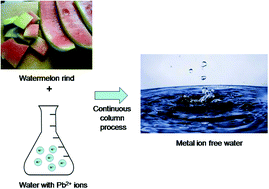A fixed bed column study for the removal of Pb2+ ions by watermelon rind
Abstract
The present study reports the feasibility of removing Pb2+ ions from aqueous solution using watermelon rind (WR) as a low cost adsorbent. Fixed bed column studies were employed to study the removal efficiency of Pb2+ ions by varying the column parameters such as flow rate, bed height and initial metal ion concentration. The results showed that breakthrough and exhaustion time increases with a decrease in flow rate, inlet concentration, and an increasing bed height. The breakthrough curves obtained were analyzed with Adams–Bohart, Thomas and Yoon–Nelson models. On comparison of the R2 values, both the Thomas and Yoon–Nelson models were found to have a better fit than the Adams–Bohart model and these two models can be used to predict the adsorption of Pb2+ ions in a fixed bed column. Desorption of Pb2+ ions on WR was repeated for three cycles in 0.1 M HCl solution. The loading capacity of WR was compared with other adsorbents and was found to be high. These results show that watermelon rind, a non-hazardous agro waste, can be successfully employed for the elimination of Pb2+ ions from aqueous solution.


 Please wait while we load your content...
Please wait while we load your content...